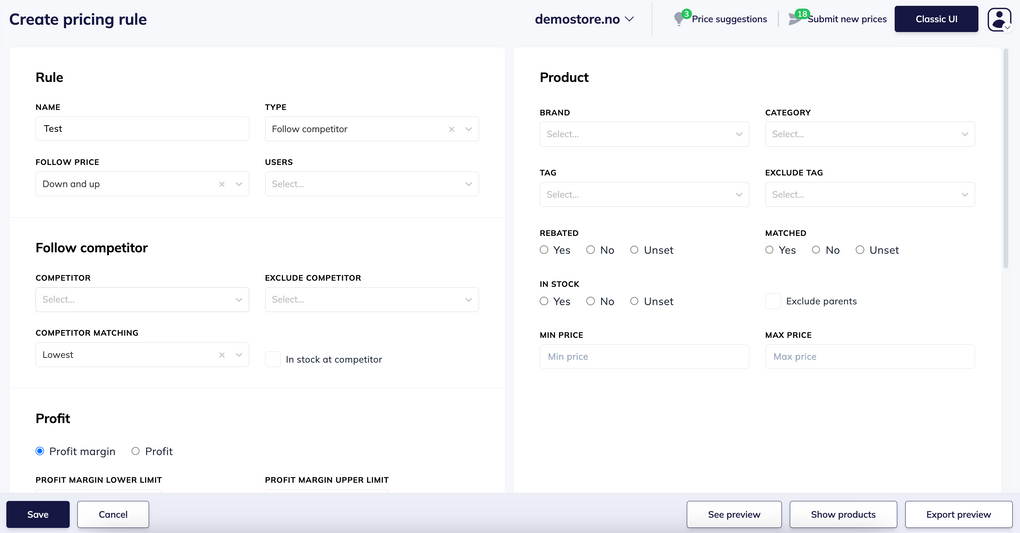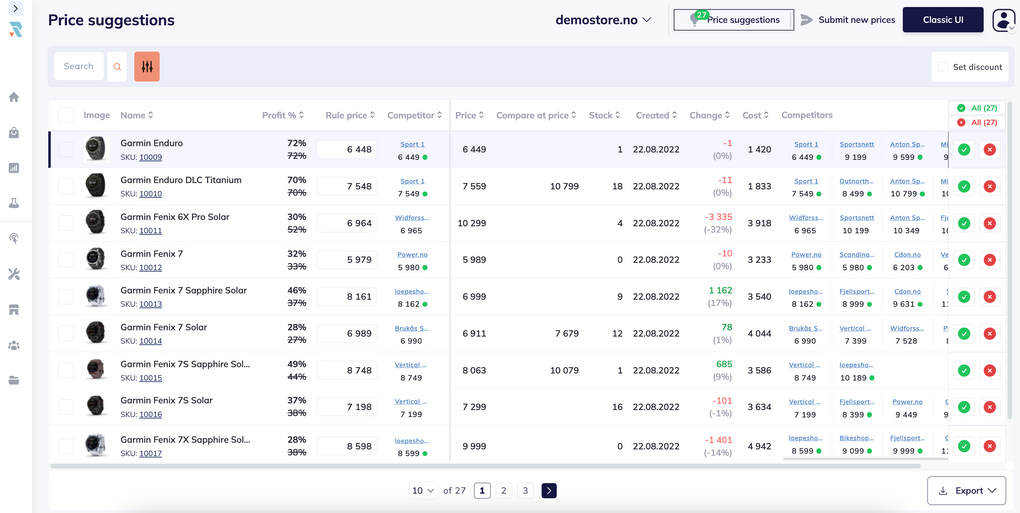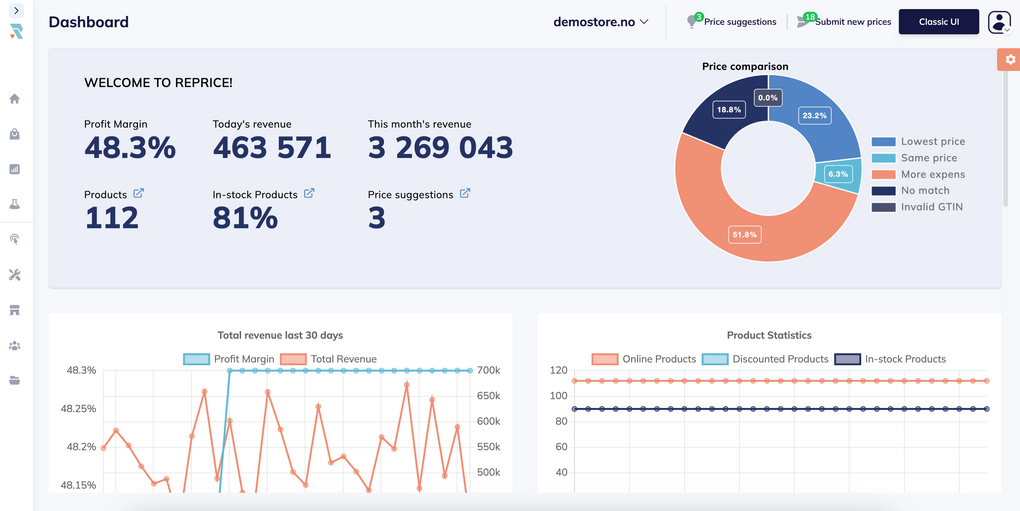Riding The Waves: How to Adapt Pricing Strategies to Seasonal E-commerce Trends
March 15, 2024 | 10 minutes read
Successfully navigating seasonal trends is a crucial skill in the vibrant arena of e-commerce.
Why?
Because as consumer habits change with all the seasons, fine-tuning your pricing strategy becomes essential if you want to adapt, maximize profits, and stay ahead of your competitors.
In this post, we'll explore the major seasonal trends that influence your customers' buying decisions.
Then, we'll guide you through adaptive pricing strategies that are not just responsive, but also proactive. These are designed to really make the most of these trends.
In this article:
- What are the biggest seasonal trends impacting e-commerce?
- Strategies for adaptive pricing during seasonal e-commerce trends
- How to adapt pricing strategies to global e-commerce trends
- Summing up
What are the biggest seasonal trends impacting e-commerce?
There's probably more to cover, but understanding these key seasonal trends is crucial for any e-commerce strategy:
1. Holiday shopping surge (November - December):
The end of the year marks a significant increase in online shopping, driven by events like Black Friday, Cyber Monday, and Christmas.
This is typically the most lucrative period for e-commerce businesses, with sales volumes reaching their peak.
In fact: In 2023, online sales during Black Friday in the US skyrocketed to an impressive $9.8 billion, marking a 7.5% increase from the previous year. Customers are increasingly embracing these major sales events, likely due to the ease of comparing prices online.
During this time, e-commerce sites see a significant rise in both traffic and sales. Retailers will often extend Black Friday and Cyber Monday deals to cover several weeks, with the aim of selling more.
So to capitalize on this, businesses can use strategies like special promotions, extended discount periods, and holiday-themed marketing. Personalized gift suggestions, festive product collections, and holiday-inspired website designs can also be used to draw in consumers.
The days leading up to Christmas are key - as retailers focus on expedited shipping and flexible return policies to cater to last-minute shoppers.
2. New year’s resolutions (January):
As the new year rolls in, it brings a wave of enthusiasm for self-improvement.
We're talking a rise of sales in fitness gear, health supplements, organizational aids, and self-help literature - you name it.
Subscription services, particularly in the realms of health, wellness, and education, typically experience a surge, as people commit to their “long-term aspirations”.
So e-commerce companies should adapt by tailoring their marketing towards products that match popular New Year's resolutions – think fitness, diet, personal organization, and learning new skills.
But the trend isn't limitied to just the usual health and wellness products you see.
There's a growing interest in categories like financial planning tools, online courses for skill enhancement, and environmentally friendly products, as more people aspire to sustainable living. Retailers can tap into this segment with more motivational messaging and customer success stories.
3. Valentine’s Day (February):
Valentine's Day brings a surge in e-commerce sales, especially in jewelry, chocolates, flowers, and unique, personalized gifts.
In 2023 alone, Valentine's Day spending in the US surged to $23.9 billion, up from the previous year. Among all age groups, younger millennials (ages 23 to 29) spent the most money, averaging $266 per person on their significant other.
During this period, online retailers can pull out all the stops with Valentine's specials, curated gift guides, and quick shipping options for those last-minute purchases. (Targeted to those who unfortunately forgot this special day).
4. Summer slowdown (June-August):
The balmy summer months bring a different rhythm to e-commerce, often seeing a slight dip as people take a step back, go offline and enjoy the outdoors and vacations.
This time can pose some challenges for online retailers, but it still opens doors for creative seasonal promotions.
Think summer fashion, travel essentials, and outdoor gear.
Despite a general slowdown in online shopping, specific sectors like outdoor sports, swimwear, and travel items tend to see a rise in sales.
Retailers use this period for inventory clearance through summer sales. It's also a great time for businesses to plan and gear up for the busier seasons ahead.
5. Back-to-school season (Late summer - early fall):
As summer winds down, the industry gets ready for the back-to-school rush. From late July through early September, there's a significant increase in sales of school essentials, apparel, and tech products.
This period is crucial for e-commerce companies that focus on school and college needs. It's a time that goes beyond just selling traditional school items like notebooks and pencils.
There's a growing demand for tech gear such as laptops and tablets, fashionable clothing, and even dorm room accessories for college-goers. In 2023, worldwide laptop shipments totaled 114.806 million units.
Retailers can form partnerships with schools for exclusive offers and create targeted marketing campaigns on social media channels to reach their key audience.
What's more, the back-to-school shopping timeline is extending, with some promotional activities kicking off as early as late June.
7 effective strategies to adapt your pricing for seasonal trends and boost profitability
Adjusting your pricing strategy to match seasonal trends is key. A smart way to do this is by using advanced tools like Reprice.
Price optimization software like Reprice allows you to shift from a reactive to a proactive pricing approach, enabling adjustments based on market dynamics, consumer demand, and seasonal fluctuations.
One of the core strategies facilitated by Reprice is:
1. Dynamic pricing models
Implementing dynamic pricing is a game-changer. It involves using algorithms to modify prices in real time.
This is based on current market demand, competitive pricing, and customer behavior trends. An approach like that is essential during periods of high demand, and equally crucial in slower seasons.
Here’s how Reprice gets you a head start when it comes to dynamic pricing:
- Automate pricing based on rules you choose: Reprice lets you define and implement rules for automatic pricing adjustments. These rules can be influenced by factors like competitor prices, minimum margins, or consumer demand, letting your prices to adapt fluidly to ongoing market changes.
- Get updated, live data on competitor pricing and strategies: Stay informed with real-time data on your competitors' pricing strategies. Reprice provides up-to-the-minute market information, ensuring that your pricing decisions are both timely and well-informed.

2. Early bird and last-minute discounts
Smart timing can be everything in e-commerce.
So by incentivizing early shopping for seasons like back-to-school and introducing last-minute deals for holidays, you can really boost sales and appeal to a much wider range of customers.
Here’s Reprice’s solution: Flexibility in price adjustment. You can easily implement both early bird specials and last-minute discounts.
Plus, use manual adjustments to create specific discount campaigns well in advance, making sure you capture the early shoppers.
Use the tool's automatic adjustments to quickly respond to market dynamics, helping you create those enticing last-minute offers that attract the "final-hour" buyers.

3. Tiered pricing strategies
Tiered pricing models can be a game-changer. Why? Because they involve offering different price levels or tiers for a product or service, providing customers with various options to choose from based on their preferences and budget.
This approach allows businesses to cater to the diverse needs of their customers - while also maximizing revenue potential. Especially during important periods like the New Year's resolutions era.
This is where Reprice becomes an invaluable tool. With its stringent control over pricing, you can fine-tune prices across a range of products, brands, or categories. However you see fit.
So whether it's adjusting for seasonality or aligning with promotional activities, Reprice helps you create effective tiered pricing that actually resonates with your customer base and market dynamics.
4. Bundling products
Bundling products at a discount is a smart move to enhance their perceived value, especially useful for boosting your average order value during gift-centric seasons like Valentine’s Day.
For instance, offering a Valentine's Day bundle with chocolates, flowers, and a greeting card at a discounted price can encourage customers to purchase more items together, increasing their overall spending while providing added value.
Reprice offers a feature for bulk pricing updates that is applicable to brands, categories, or tags.
This function is incredibly helpful for bundling, because it allows you to efficiently adjust prices for tons of products in a bundle.
So whether it's for seasonal campaigns or special promotions, Reprice simplifies the process. Helping ensure that your bundled offers are priced perfectly for the occasion.
5. Flash sales and limited-time offers
Time-sensitive sales create a sense of urgency, which can be a real catalyst for quick revenue boosts.
This strategy works wonders not just in peak seasons, but also in tackling slower periods, like the summer slowdown.
Reprice features daily price recommendations that align with current market trends.
This is incredibly useful for businesses looking to jump on fresh market opportunities with flash sales or limited-time offers.
Plus, these daily insights help you pinpoint the perfect timing and products for your promotions, making your strategy just as responsive as it is effective.

6. Loyalty and reward programs
Building or improving loyalty programs where customers rack up points with every purchase is a clever way to boost repeat business. Why?
Because it keeps your customers engaged all year round.
In January 2023, interest in loyalty programs went up by 50%, with a significant uptick in searches for terms like "reward program" and "loyalty points."
Now, this is where Reprice truly adds value. It syncs your product data smoothly with your other main business platforms.
This seamless integration is crucial for keeping your product information accurate and consistent.
Why does this matter? Well, it's key for tracking customer purchases accurately - and for running your loyalty and rewards programs effectively. So that there’s no inconsistency in sight when it comes to rewarding your loyal customers and providing them with the best experience possible.
So with the tool, you're ensuring that every purchase counts towards building lasting customer loyalty.
7. Analyzing past data for price optimization
Using past sales data to shape your pricing strategies is a smart, data-driven move. It means you can make better choices by looking at what happened before and what customers do. Helping you set prices just right, match what people want and ultimately - you make more money.
This is where Reprice plays a role. Its integrated dashboard provides a complete overview of your products and sales performance.
Having all this data at your fingertips is crucial for dissecting your past sales trends.
In the end, it guides you in making more informed pricing strategies for the future that actually work - grounded in solid historical data at your fingertips.
That way, you’re not just guessing at prices – you’re strategically setting them based on proven performance.

How to adapt pricing strategies to global e-commerce trends
Today, companies are constantly adapting their pricing processes and strategies to keep up with global trends.
Customers now expect seamless online and in-store experiences (otherwise known as omnichannel), personalized services, quick and sustainable deliveries. And a genuine commitment to privacy.
Reprice is helping businesses navigate these trends.
It offers solutions for hybrid retail, helping you cater to both online and physical stores. Plus, supports 'multi-local' commerce by allowing dynamic pricing adjustments for different regions.
For the eco-conscious people out there, Reprice aids in pricing sustainably-made products attractively. It also ensures secure data management, aligning with enhanced privacy demands and regulations.
By leveraging tools like Reprice, businesses can align their pricing strategies with these global e-commerce trends, balancing customer satisfaction with profitability.
This approach is crucial for thriving in the competitive and ever-changing global market.
Summing up
Understanding and adapting to seasonal shifts in consumer behavior is key for e-commerce success.
From the holiday shopping surge to the summer slowdown, each season brings its own set of challenges and opportunities.
Implementing strategies like dynamic pricing, early bird and last-minute discounts, tiered pricing, and leveraging tools like Reprice can significantly enhance profitability and customer satisfaction.
Ready to get started with Reprice? Book a demo here.
Robin Frugaard Jørgensen
Chief Commercial Officer at Reprice
Robin Frugaard Jørgensen is Chief Commercial Officer at Reprice. Prior to joining Reprice in January 2023, Robin spent several years working with pricing strategies in B2B & the consumer electronics industry. Connect with Robin on LinkedIn here or book a demo to see how Reprice can solve your e-commerce pricing challenges.
